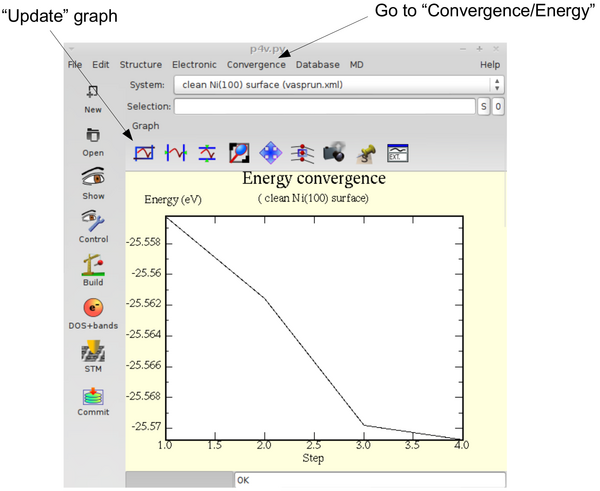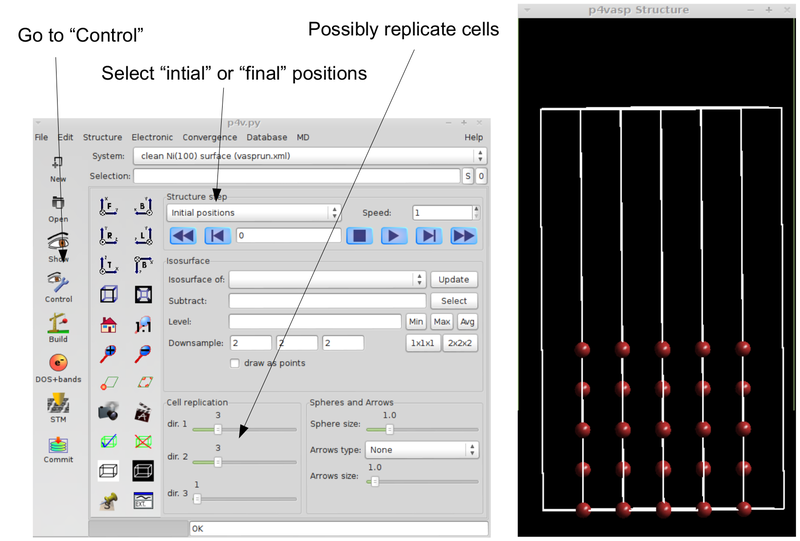Ni 100 surface relaxation
Overview > Ni 100 surface relaxation > Ni 100 surface DOS > Ni 100 surface bandstructure > Ni 111 surface relaxation > CO on Ni 111 surface > Ni 111 surface high precision > partial DOS of CO on Ni 111 surface > vibrational frequencies of CO on Ni 111 surface > STM of graphite > STM of graphene > collective jumps of a Pt adatom on fcc-Pt (001): Nudged Elastic Band Calculation > List of tutorials
Task
Relaxation of the first two layers of a Ni (100) surface.
Input
POSCAR
fcc (100) surface 3.53 .50000 .50000 .00000 -.50000 .50000 .00000 .00000 .00000 5.00000 5 Selective Dynamics Kartesisch .00000 .00000 .00000 F F F .00000 .50000 .50000 F F F .00000 .00000 1.00000 F F F .00000 .50000 1.50000 T T T .00000 .00000 2.00000 T T T
- Ni lattice constant of 3.53[math]\displaystyle{ \AA }[/math].
- 1 atom per layer: p(1x1) cell.
- 5 nickel layers.
- First two layers (of one side) relaxed.
- [math]\displaystyle{ 3\times3.53 = 10.59 \AA }[/math] vacuum.
INCAR
ISTART = 0; ICHARG = 2 general: SYSTEM = clean Ni(100) surface ENCUT = 270 ISMEAR = 2 ; SIGMA = 0.2 ALGO = Fast EDIFF = 1E-6 spin: ISPIN=2 MAGMOM = 5*1 dynamic: NSW = 100 POTIM = 0.8 IBRION = 1
- Initial charge-density in startjob from overlapping atoms.
- Default energy cut-off of 270 eV.
- MP-smearing (metal).
- Spin-polarized calculation with initial moment of 1.
- Ionic relaxation used.
KPOINTS
k-points 0 Monkhorst-Pack 9 9 1 0 0 0
- Equally spaced mesh.
- Odd mesh, centered on [math]\displaystyle{ \Gamma }[/math].
- 15 k points in irreducible Brillouin zone (IBZ).
- Only one k point in z-direction for surface.
Calculation
- The sample output for the forces in the OUTCAR file should look like this (first and last step):
First step:
POSITION TOTAL-FORCE (eV/Angst)
-----------------------------------------------------------------------------------
0.00000 0.00000 0.00000 0.000000 0.000000 0.391352
0.00000 1.76500 1.76500 0.000000 0.000000 -0.397024
0.00000 0.00000 3.53000 0.000000 0.000000 0.005117
0.00000 1.76500 5.29500 0.000000 0.000000 0.391161
0.00000 0.00000 7.06000 0.000000 0.000000 -0.390607
-----------------------------------------------------------------------------------
total drift: 0.000000 0.000000 0.016391
Last step:
POSITION TOTAL-FORCE (eV/Angst)
-----------------------------------------------------------------------------------
0.00000 0.00000 0.00000 0.000000 0.000000 0.399012
0.00000 1.76500 1.76500 0.000000 0.000000 -0.377003
0.00000 0.00000 3.53000 0.000000 0.000000 0.105799
0.00000 1.76500 5.32685 0.000000 0.000000 -0.062054
0.00000 0.00000 7.02377 0.000000 0.000000 -0.065753
-----------------------------------------------------------------------------------
total drift: 0.000000 0.000000 -0.042925
- Energy changes during relaxation from -25.556 to -25.571 eV which gives a relaxation energy of [math]\displaystyle{ E^{\mathrm{rel}} = -15 }[/math] meV. Use p4vasp to check the convergence:
- The surface energy of 0.86 eV for the unrelaxed surface is calculated in the following:
[math]\displaystyle{ \sigma^{\mathrm{unrel}} = \frac{1}{2} (E_{\mathrm{surf}}-N_{\mathrm{atoms}} \cdot E_{\mathrm{bulk}}) = \frac{1}{2} (-25.556-5\cdot(-5.457))= 0.86 }[/math] eV.
- The surface energy of 0.84 eV for the relaxed surface is then calculated as:
[math]\displaystyle{ \sigma = \sigma^{\mathrm{unrel}} + E^{\mathrm{rel}} = 0.84 }[/math] eV.
fcc (100) surface
3.53000000000000
0.5000000000000000 0.5000000000000000 0.000000000000000
-0.5000000000000000 0.5000000000000000 0.000000000000000
0.0000000000000000 0.0000000000000000 5.000000000000000
Ni
5
Selective Dynamics
Direct
0.0000000000000000 0.0000000000000000 0.0000000000000000 F F F
0.0000000000000000 0.5000000000000000 0.1000000000000014 F F F
0.0000000000000000 0.0000000000000000 0.2000000000000028 F F F
0.5000000000000000 0.5000000000000000 0.3018043743226639 T T T
0.0000000000000000 0.0000000000000000 0.3979474020596729 T T T
- Inward relaxation of surface layers:
- [math]\displaystyle{ \Delta d_{12} }[/math] = ((0.3979-0.3018)-0.1)/0.1*100=-3.9%.
- [math]\displaystyle{ \Delta d_{12} }[/math] = ((0.3018-0.2000)-0.1)/0.1*100=+1.8%.
- Use p4vasp to visualize the relaxation:
Download
Overview > Ni 100 surface relaxation > Ni 100 surface DOS > Ni 100 surface bandstructure > Ni 111 surface relaxation > CO on Ni 111 surface > Ni 111 surface high precision > partial DOS of CO on Ni 111 surface > vibrational frequencies of CO on Ni 111 surface > STM of graphite > STM of graphene > collective jumps of a Pt adatom on fcc-Pt (001): Nudged Elastic Band Calculation > List of tutorials


